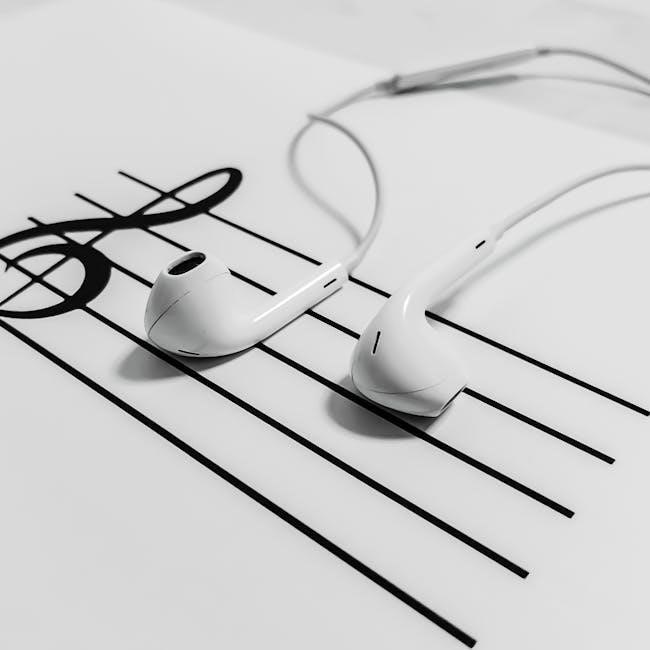The treble clef, also known as the G clef, is a musical symbol used to identify higher-pitched notes on the staff. It is essential for reading sheet music.
What is the Treble Clef?
The treble clef, also known as the G clef, is a musical symbol used to indicate the pitch of notes on a staff. It is one of the most common clefs in music notation. The treble clef is named for its resemblance to a stylized letter “G,” which circles the second line of the staff, representing the note G. This clef is primarily used for higher-pitched instruments, such as the violin, flute, and piano, as well as vocal music. The staff consists of five lines and four spaces, with each line and space assigned specific note names. Understanding the treble clef is fundamental for reading sheet music and playing musical instruments. It serves as a guide to accurately interpret the pitch and position of notes on the staff.
Importance of the Treble Clef in Music
The treble clef plays a crucial role in music notation by ensuring accuracy in pitch recognition. It is essential for musicians to understand the treble clef, as it guides the interpretation of higher-pitched notes. This clef is widely used across various instruments and vocal music, making it a fundamental element in sheet music. Without the treble clef, musicians would struggle to identify the correct notes, leading to potential errors in performance. Its standardized use ensures consistency and clarity in musical communication. Additionally, the treble clef aids in sight-reading, enabling musicians to quickly recognize notes and play with precision. This clef is also integral to music education, as it forms the basis for teaching note-reading skills to students.

Structure of the Treble Clef Staff
The treble clef staff consists of five lines and four spaces, providing a framework for placing musical notes. Each line and space represents specific pitches.
Understanding the Lines and Spaces
The treble clef staff is composed of five horizontal lines and four spaces. Each line and space represents specific musical notes. The lines, from bottom to top, are labeled E, G, B, D, and F. The spaces, from bottom to top, are labeled F, A, C, and E. These letter names are essential for identifying pitches. Mnemonics like “Every Good Boy Does Fine” for the lines and “FACE” for the spaces help musicians remember the note names. Understanding the layout is crucial for reading sheet music accurately. The structure ensures that musicians can quickly identify where notes are placed, making it easier to play instruments or sing. This foundational knowledge is vital for mastering music theory and sight-reading.
The Five-Line Staff and Four Spaces
The treble clef staff is standardized with five horizontal lines and four vertical spaces. These lines and spaces provide a consistent framework for placing musical notes. Each line and space is assigned a specific letter name, ensuring clarity in pitch recognition. The five-line structure allows for a wide range of notes to be represented, while the four spaces fill in the gaps between the lines. This design creates a visual system that is easy to follow, enabling musicians to quickly identify note positions. The combination of lines and spaces forms the backbone of music notation, making it possible to communicate musical pitches with precision. This standardized system is universal, ensuring that musicians worldwide can interpret sheet music effectively. PDF resources often include exercises to practice identifying notes on the five-line staff.

Lines of the Treble Clef
The treble clef staff consists of five lines, named E, G, B, D, and F. These lines provide a framework for placing musical notes accurately.
Naming the Lines (E, G, B, D, F)
The lines of the treble clef staff are named E, G, B, D, and F. These letters correspond to the musical notes placed on each line. The naming starts from the bottom line (E) and moves upward. Each line represents a specific pitch, with E being the lowest and F the highest. This system allows musicians to identify notes quickly and accurately. Mnemonic devices, such as “Every Good Boy Does Fine,” help remember the sequence. Understanding these line names is crucial for reading sheet music and playing instruments that use the treble clef. Regular practice with exercises from PDF resources can enhance note recognition and overall musical literacy.
Mnemonic Devices for Remembering Line Notes
Mnemonic devices are helpful tools for remembering the names of the lines on the treble clef staff. The most common phrase used is “Every Good Boy Does Fine”, where each word corresponds to the notes E, G, B, D, and F. This phrase creates a mental image, making it easier to recall the order of the notes; Other variations include “Eddie Goes Down For A Bite” or “Everybody’s Gone Bowling Down Freeways”. These mnemonics are designed to associate the note names with memorable sentences or phrases. By practicing these devices, musicians can quickly identify the notes on the staff. PDF resources often include exercises that incorporate these mnemonics, reinforcing their effectiveness in musical education.

Spaces of the Treble Clef
The four spaces between the lines of the treble clef staff are named F, A, C, and E. These notes are often remembered using the mnemonic “FACE.”
Naming the Spaces (F, A, C, E)
The spaces on the treble clef staff are named F, A, C, and E. These notes are positioned between the lines and are essential for reading sheet music. The sequence of these notes corresponds to the spaces from bottom to top. The mnemonic “FACE” is widely used to remember the order of these notes. PDF resources provide exercises and worksheets to practice identifying these notes. By using these materials, musicians can improve their ability to recognize and write notes on the treble clef staff. Understanding the spaces is crucial for accurately reading musical compositions and performing with precision. These resources are ideal for both beginners and advanced learners seeking to refine their skills.
Mnemonic Devices for Space Notes
Mnemonic devices are helpful tools for remembering the names of the spaces on the treble clef staff. The most common mnemonic for the spaces (F, A, C, E) is the phrase “FACE,” where each letter corresponds to a note. Other creative mnemonics include “Father Charles’ Ears” or “Funky Monkeys Eat Bananas.” These phrases are designed to be memorable and aid in associating the notes with their positions. PDF resources often include these mnemonics along with exercises to practice note recognition. By using these devices, musicians can quickly and accurately identify the notes in the spaces of the treble clef staff, enhancing their ability to read sheet music effectively. These tools are particularly useful for beginners learning to navigate musical notation.

PDF Resources for Treble Clef Notes
Free PDF resources are widely available online, offering worksheets, exercises, and guides to master treble clef notes. Websites like HelloMusicTheory.com and musictechteacher.com provide downloadable materials for note recognition and practice. These PDFs include exercises for identifying lines and spaces, ledger lines, and accidentals. Many resources feature interactive drills, quizzes, and mnemonic devices to aid learning. Additionally, some PDFs focus on harmony and sight singing exercises, making them ideal for both classroom and individual practice. These tools are essential for musicians aiming to improve their ability to read and interpret treble clef notation effectively.
Free Worksheets and Exercise PDFs
Free PDF worksheets and exercises are widely available online to help musicians master treble clef notes. Websites like HelloMusicTheory.com and musictechteacher.com offer downloadable resources with exercises for note recognition, ledger lines, and accidentals. These PDFs include interactive drills, quizzes, and mnemonic devices to aid learning. Many resources feature exercises for labeling lines and spaces, as well as identifying notes on the staff. Some PDFs also include crossword puzzles and sight singing exercises to enhance musical skills. These free materials are ideal for both classroom use and individual practice. They provide a comprehensive way to improve note-reading abilities and are essential tools for musicians of all skill levels.
Downloading and Printing Treble Clef PDFs
Downloading and printing treble clef PDFs is a straightforward process. Websites like Notebusters and musictechteacher.com offer free PDFs that can be instantly downloaded. These resources often come in high-quality formats suitable for printing. Ensure your device has a PDF reader installed to access the files. Once downloaded, print the worksheets on standard paper for practice. Many PDFs are designed with clear layouts, making them ideal for music students. Some sites also offer MIDI files for additional learning tools. By downloading and printing these resources, musicians can engage in effective practice sessions anytime, anywhere. This accessibility makes learning the treble clef notes more convenient and efficient for everyone.

How to Read Treble Clef Notes
To read treble clef notes, identify their positions on the staff. Notes on lines are E, G, B, D, F, while spaces are F, A, C, E. Ledger lines extend the staff for higher or lower pitches. Accidentals like sharps and flats modify note pitches. Recognizing these elements helps in accurately interpreting musical notation.
Identifying Note Positions on the Staff
The treble clef staff consists of five lines and four spaces, each assigned specific note names. Lines are labeled E, G, B, D, F, while spaces are F, A, C, E. Notes placed on lines or spaces correspond to these letters. Ledger lines extend beyond the staff to accommodate higher or lower pitches. To identify positions, start by locating the clef and associating each mark with its respective line or space. This method ensures accurate note recognition and proper pitch identification. Regular practice with PDF exercises helps reinforce this skill, making sheet music reading more intuitive for musicians and students. Mastery of note positions is fundamental for proficient music literacy.
Understanding Ledger Lines and accidentals
Understanding Ledger Lines and Accidentals
Ledger lines extend beyond the staff to represent notes outside the standard range. In treble clef, they often indicate higher pitches. Accidentals (sharps, flats, naturals) modify note pitches. Sharps (#) raise pitch by a half-step, while flats (♭) lower it. Naturals (♮) cancel previous accidentals. These symbols appear directly to the left of the affected note. Ledger lines and accidentals are crucial for accurate pitch recognition. PDF resources provide exercises to practice identifying these elements. Regular practice with ledger lines and accidentals improves sight-reading and music literacy. These tools are essential for mastering the treble clef staff and enhance overall musical understanding.

Practicing with Treble Clef Exercises
Free PDF worksheets offer exercises to improve note recognition, ledger lines, and accidentals. Interactive drills and quizzes enhance practice, providing comprehensive treble clef mastery.
Exercises for Note Recognition
Engage with PDF worksheets designed to enhance note recognition skills on the treble clef staff. These exercises include labeling notes on lines and spaces, tracing clefs, and rewriting notes in different positions. Interactive drills provide immediate feedback, helping users identify and correct mistakes. Quizzes cover various note positions, including those requiring ledger lines. Mnemonic devices are often included to aid memory. These resources cater to both beginners and advanced learners, offering a structured approach to mastering treble clef notation. Regular practice with these exercises ensures improved sight-reading abilities and a stronger understanding of musical notation.
Interactive Drills and Quizzes in PDF Format
Enhance your learning experience with interactive PDF drills and quizzes designed to test and improve treble clef note recognition. These resources often include multiple-choice questions, note-identification exercises, and interactive flashcards. Some PDFs feature clickable elements that provide immediate feedback, helping you track your progress. Exercises may focus on specific skills, such as identifying notes on lines, spaces, or ledger lines. Additionally, quizzes may include rhythm exercises or note-naming games to keep practice engaging. Many PDFs are downloadable and printable, making them ideal for both classroom and self-study. They are especially useful for reinforcing concepts learned in music theory lessons or when preparing for exams. Regular use of these tools ensures a solid foundation in treble clef notation.

Applications of Treble Clef Knowledge
Understanding the treble clef is crucial for reading sheet music, playing instruments like the piano or violin, and composing music. It also aids in teaching music theory concepts effectively.
Reading Sheet Music and Scores
Mastering the treble clef is fundamental for reading sheet music and scores accurately. It allows musicians to identify pitches and intervals, ensuring proper execution of melodies and harmonies. With treble clef knowledge, performers can decipher notes on the staff, understand key signatures, and interpret dynamics. This skill is vital for pianists, vocalists, and instrumentalists, enabling them to sight-read effectively. Free PDF resources, such as worksheets and exercises, provide ample practice material to enhance note recognition and fluency. By linking notes to their positions on the staff, musicians can develop a deeper connection to the music, fostering better performance and creativity. Regular practice with PDF exercises strengthens this essential music-reading ability, benefiting both beginners and advanced learners alike.
Playing Instruments Using Treble Clef Notes
Understanding treble clef notes is crucial for instrumentalists, as it directly translates to pitches on their instruments. Pianists, guitarists, and wind players rely on the treble clef to interpret sheet music accurately. Each note’s position on the staff corresponds to specific keys or fingerings, enabling precise performance; For instance, a piano’s right-hand melodies often use treble clef notation, while guitars use it for higher-pitched strings. Additionally, wind instruments like flutes and violins primarily use the treble clef. By mastering treble clef notes through PDF exercises and worksheets, musicians can enhance their playing technique and fluency. This skill is indispensable for sight-reading, improvisation, and mastering complex musical pieces, making it a cornerstone of instrumental proficiency.
